ITS is an acoustical engineering office based near Lyon (in the Rhône-Alpes-Auvergne region) which intervenes everywhere in France (Europe), and also in the neighboring countries.
Main activities of acoustical engineering office ITS
Main activities of acoustical engineering office ITS are in relation to:
- the limitation of noise transmission in ducts
- the sound transmission through partitions
- the sound absorption
- the sound propagation inside rooms
- the sound transmission outside of buildings
- the sound propagation outdoor
They include (which can be combined according to engineering needs):
- on-site measurements of sound levels (in all contexts: building, environment, industry), reverberation time and spatial sound decay rate (in premises) and comparison with reference values (regulatory, normative or from specifications technical) for an examination of the conformity of installations; such diagnostics are carried out:
- by a workforce experienced in physical measurements, specialized in instrumental techniques
- with duly calibrated and verified noise generators and sound level meters
- before and/or after sound insulation and reverberation control works
- research and development of solutions for improving a situation, sizing of noise control and soundproofing equipment with simulations of acoustic performance verifiable on site (such missions of engineering are carried out by a human resource qualified in building physics, experienced in acoustics and in related fields e.g thermal, aeraulics and fluid mechanics, construction technologies)
- partitions e.g. noise barriers, floors, walls and roofs of buildings and other constructions (housing, premises of public acces buildings - PAB -, all industrial sectors) including enclosures for noisy machines and equipment of all kinds and of all sizes
- silencers (mufflers) for air at ambient temperature (for Heating Ventilation Air Conditioning - HVAC - facilities, for equipment comprising fans and for the air intake of turbomachines) and for industrial fluids at low temperature (e.g. pressurized gas expansion) or at high temperature (exhaust from heat engines, gas turbines and other materials related to combustion processes)
- advice and technical prescriptions for noise reduction and improvement of acoustic comfort in all contexts
- limitation of sound propagation (inside buildings or outside) from equipment of all kinds or from networks (aeraulic or pressurized fluids)
- control of sound environments (living spaces, including workspaces - offices, workshops and other production premises - or premises dedicated to training, restaurants, sports halls)

the measurement of sound levels often bases the diagnosis of the acoustic design office ITS |
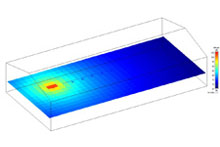
simulation using software (for analysis of sound propagation in open or enclosed environments) is frequently a key step for the research and development of soundproofing solutions by the acoustical engineering office ITS |
|
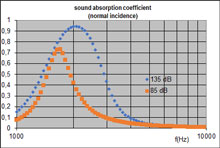
modeling the sound absorption of multilayered structures is a specialty of ITS (above: sound absorption coefficient as a function of frequency for 2 excitation levels of a perforated structure) |
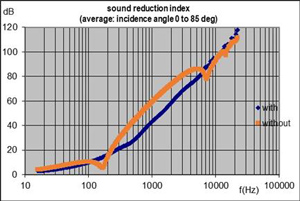
the calculation of the sound reduction index of multi-layered structures by the acoustical engineering office ITS allows applications in construction sector and in industrial field (above: sound reduction index as a function of frequency for an acoustic structure with or without mechanical connections) |
|

the transmission of sound towards buildings outside is studied by the acoustical engineering office ITS using specific software, developed in-house (above: map of noise transmitted by a heterogeneous wall with soundproofing panels, acoustic doorsets and ventilation silencers) |
||
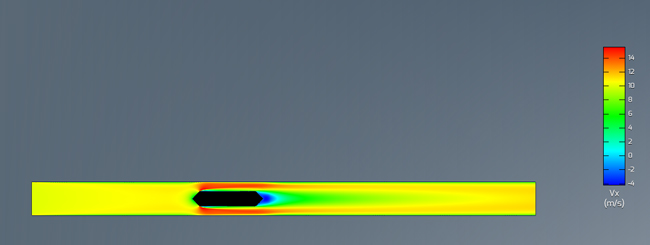
the acoustical and aeraulic sizing of silencers can be carried out by the acoustical engineering office ITS using software developed in-house or using a license of commercial finite element calculation software (FEM) and computational fluid dynamics (CFD)(above modeling of the gas speed in a duct with a silencer i.e. a noise reduction device) |
||
Services of acoustical engineering office ITS
ITS's engineering services in acoustics are related in particular to the problems of noise at work or in the environment of industrial sites, and to the problems related to the acoustic comfort of buildings. They frequently have to do with excessive noise levels or room reverberations, which cause discomfort in the less worrying cases, and the risk of deafness in the most serious cases. Not unsual is that they are aimed at the dimensioning of soundproofing equipment, often in the context of the improvement of a given acoustic situation e.g. with regard to the respect of the acoustic regulation or to prevent nuisances and nonconformities.
In industry, ITS's acoustical engineering services are namely concerning noisy production equipment (machines of all types, in all sectors of activity) and ancillaries such as ventilators, compressors, air coolers, dust removal networks, which are likely, when installed indoors or outdoors, to involve for workers noise exposure situations of and / or cause inconvenience to neighbors (for local residents or sometimes for remote homes).

The experience acquired by the human resources of the acoustic design office ITS counts to apprehend in the best possible way the various soundproofing problems of the industrial sector. |
In the case of power plants in particular, ITS’s on-site measurements and calculation notes are often related to thermal engines or gas turbines, of which noise emissions must be limited: for air intake (with a sophisticated filtration system) and for exhaust (at the outlet of industrial chimneys: sometimes of significant height) by the means of silencers, and for which the acoustic impact of buildings (sometimes: large in size) that house them (of which reverberation one should also limit for maintenance personnel) and of associated ventilation systems should be controlled.
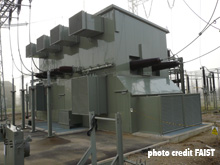
enclosure for a transformer |
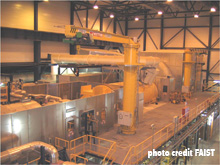
enclosure for a steam turbine and screen for a generator (indoor) |
Energy production plants (whether the noise issue is with respect to the neighborhood or with respect to employees in machinery halls) is a recurring field of intervention for the acoustical engineering office ITS, with regard both to building envelope elements and to soundproofing devices for gas flow openings, stacks outlets and discharge nozzles that silencers are. |
On the occasion of the services of acoustical engineering carried out by ITS, the search for performance in aerolics or aeraulics (aerodynamics) is therefore often associated with the development of soundproofing equipment (for the design of depressurizing silencers, complex fluid mechanics computations are necessary for the consideration of fluid networks e.g. with control valves).
In addition, thermal insulation should of course not be neglected when dimensioning the casing of mufflers for hot gases e.g. exhaust gas commonly reaching a temperature of 500 degrees C. ITS human resource has the required engineering skills and a long experience in these different fields.
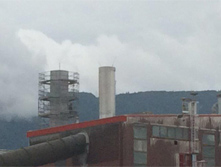
Soundproofed ndustrial chimney (stack) |
Whether exhaust from combustion processes (e.g. involving turbines, heat engines) or other processes (e.g. with a fan in the lower part), industrial chimneys that need to be soundproofed are frequently the subject of sizing work by the ITS acoustic design office. In this area, the development of silencers for noise reduction - with a view to preserving the neighborhood - requires careful calculations in terms of aeraulics, for which ITS has specific software. |
|
With regard to industrial sites, the intervention of the ITS acoustic design office may be motivated in particular by:
- considerations related to the preservation of the environment, to avoid non-conformities:
- in France, a regulatory non-compliance can have different origins:
- exceeding of the admissible limit for emergence: this is the difference between the A-weighted equivalent continuous pressure levels of the ambient noise - considered industrial site considered in operation - and of the residual noise - in the absence of noise generated by the considered industrial site, but measured over its operating period) in zones with regulated emergence (ZRE); depending on the context: 5 or 6 dB(A) during the day and 3 or 4 dB(A) during the night
- presence of a tonal component: when, considering an unweighted third-octave spectrum due to the operation of the indtsrial site, the level in a frequency band exceeds by 5 dB or more the average level of the two adjacent frequency bands from 400 Hz to 6300 Hz or 10 dB that of the two adjacent frequency bands from 63 to 315 Hz
- exceeding the permissible level at the property boundary, set by prefectural decree - typically 70 dB(A) during the day, 60 dB(A) during the night -
- considerations related to the protection of employees, so as not to contravene the law:
- in France, the respect of the regulation is determined in accordance with European directive 2003/10/EC, for the daily noise exposure level L EX, 8hours: 80 dB(A) and 85 dB(A) are the thresholds, respectively lower and upper, triggering the action; 87 dB(A) is the authorized limit value
- in France, the decree of August 30, 1990 is taken for the application of article R. 235-11 of the labor code and relating to the acoustic correction of work premises: this text is applicable in France relating to the acoustic characteristics of work premises and in particular with respect to the decrease in the sound level by doubling the distance to the source
For building projects (e.g. acoustic correction of restaurants, meeting rooms, school premises or sports facilities, and also offices), on-site measurements to characterize the reverberation are often necessary and predictive acoustic calculations must be carried out before the installation works of sound-absorbing linings, so that the latter are suitably selected for their acoustic performance (frequency-varying absorption coefficient), their quantity and their implantation.
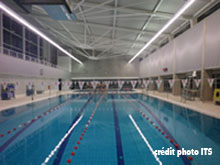
absorbing lining for walls in a sport facility (swimming pool) |
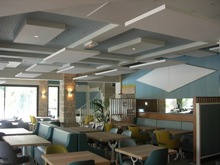
roof suspended absorbing elements for noise reduction |
The expertise of the ITS acoustic design office extends to improving the acoustic comfort of many living spaces: reception of young children (nurseries), education and training, sports and leisure, catering (including school canteens and company restaurant rooms), healthcare. |
As far as buildings are concerned, the intervention of the ITS acoustical engineering office can be motivated in particular by:
- an objective of compliance with regulatory requirements in terms of reverberation limitation in premises (conditioning the acoustic quality of speaking and listening rooms, and allowing the limitation of noise in many contexts) ; variable depending on premises nature, they are detailed in other pages of this site.
- an objective compliance with law regarding the noise of Heating Ventilation Air Conditioning (HVAC) equipment: on the one hand for the acoustic comfort of the occupants of a considered construction (e.g. collective housing, office building, health establishment, hotel) and on the other hand for the preservation of the neighborhood from any noise annoyance
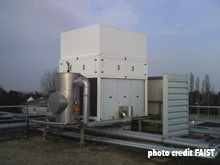
sound attenuator for an Air Handling Unit (AHU) (exhaust) |
-hardware.jpg)
noise barrier wall for aerocondensers |
For Heating Ventilation Air Conditioning (HVAC) installations, heat pumps, Air Handling Units (AHU), air condensers whose noise emissions must be limited (both with respect to the interior of buildings and with respect to the environment) are often the subject of measurements and dimensioning, by ITS acoustical engineering office, of sound attenuators: noise barrier walls and silencers. |
With regard to such projects in relation to acoustical insulation, for which the stakes, in regard to acoustics, can be such as to condition the maintenance of some industrial activities, or the habitability of some building spaces, the human resource of ITS has a solid experience, advanced measurements means and sizing tools, as well as appropriate partnerships to solve problems of noise or poor soundproofing of premises, whatever the level of technicality required: ITS acoustical engineering office services are periodically assessed in accordance with the requirements of ISO 9001 (for engineering and software edition).